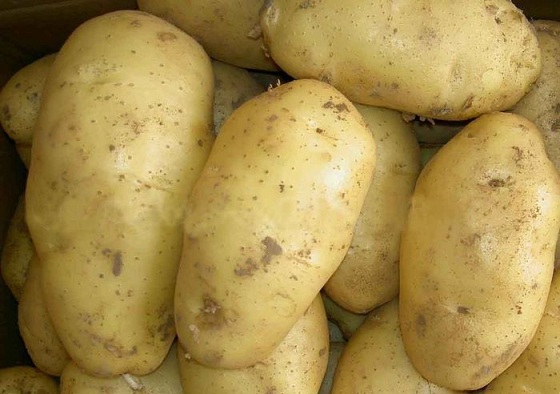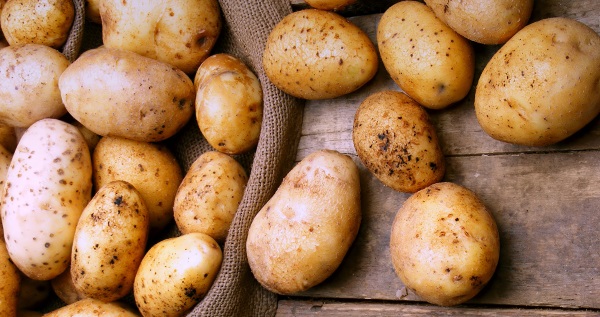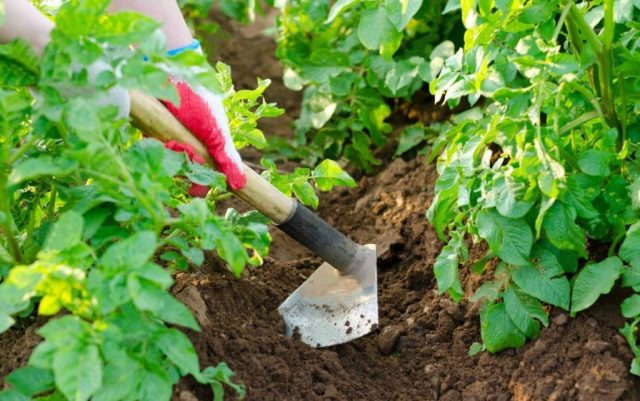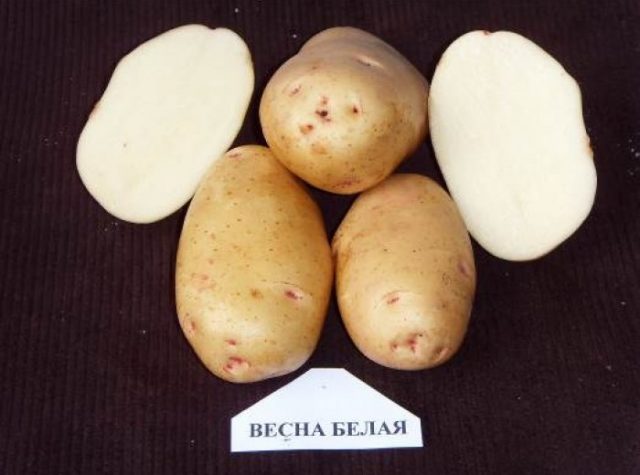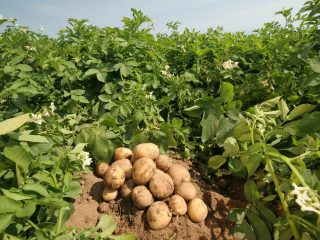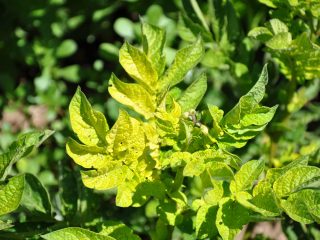Content
Description of the potato variety Vesna, photos and reviews of experienced gardeners indicate that the culture is very popular among land owners due to its excellent characteristics. To obtain a high yield, growing potatoes in Spring has its own characteristics.
Characteristics of the potato variety Vesna
Spring potatoes are an early ripening variety for table use. The plant is a bush consisting of several stems with large bright green leaves of a light shade of a pronounced pinnately dissected form.
The culture has a fibrous root system without a central root. The depth of placement in the ground is 30 - 60 cm from the outer layer.
Tubers are formed by the transformation of shoots on underground stems, at the ends of stolons. Ripe spring potatoes, white or pink, oval in shape with axillary buds on a smooth surface. The mass of tubers is about 90 - 140 g.
The plant culture of this variety does not tolerate weather fluctuations with minus marks on the thermometer. The most favorable temperature for short flowering of potatoes is 17 - 23 ° C.
Despite the fact that the variety has not yet been included in the State Register, its cultivation in individual plots of Russia has become actively spread due to positive assessments of the main characteristics of the crop.
Taste qualities of spring potatoes
Spring potatoes have positive nutritional characteristics. The pulp does not disintegrate during boiling, retains its color. Tubers are successfully used for the preparation of various daily and festive dishes, snacks, chips. At the same time, the Vesna variety is distinguished by excellent taste characteristics, thanks to which it gained popularity.
Pros and cons of the variety
The cultivation of potatoes of the Vesna variety by gardeners has characteristic positive aspects. These include:
- rapid ripening of tubers;
- low vulnerability to disease occurrence;
- high yield percentage;
- preservation of taste and external characteristics;
- high nutritional value: potatoes supply the human body with potassium and phosphorus, contain a large number of nutrients, including magnesium; B vitamins and others.
The minus is the possible response of sprouted shoots to fluctuations in air temperature, including frost.
Planting and caring for potatoes Spring
Vesna potatoes need timely attention and take the necessary care from the moment of planting. To achieve sufficient air flow into the inner layers of the soil, it is recommended to periodically loosen the beds with potatoes, and also free them from weeds... An effective way to control weeds is to cover the topsoil with mulch.
In addition, caring for potatoes involves the implementation of agrotechnical measures:
- systematic watering;
- performing hilling;
- introducing useful elements into the earth.
Selection and preparation of the landing site
It is recommended to plant the variety on land plots where this crop has not been grown for 2 - 3 years.Spring potatoes are good to plant after legumes, cabbage, root crops, cucumbers, pumpkin seeds. Conversely, planting a crop is highly undesirable after sunflowers, sorghum, tomatoes and other plants of the Solanaceae family. Before use, the soil is prepared in advance, even in the fall. To do this, it is dug up and fertilized.
With high acidity of the soil, lime material or chalk is used. To increase the fertility of clay soil, sand, peat, or complex organic fertilizers are additionally introduced.
Preparation of planting material
Tubers for planting are prepared after harvest in the fall. For this, mainly medium-sized root crops are selected, placed in a dark, cool place, for example, in a cellar. Approximately 20 - 30 days before planting, the material is transferred from the basement to a place with direct access to light. Potato tubers are sorted, getting rid of spoiled and not germinated tubers.
Landing rules
When planting spring potatoes in the soil, certain recommendations should be followed. The depth of the holes depends on the composition of the soil: on heavy, dense soils, the depth is 4 - 6 cm, on sandy and light soils - 8 - 12 cm.
Among the basic landing rules, the following are distinguished:
- use only selected healthy tubers with sprouts;
- 2 - 4 weeks before the procedure, planting raw materials are transferred from the basement to a warm, bright place;
- planting tubers is carried out only in a heated loosened soil with a temperature of at least 10 ° C;
- provide regular watering mainly in the evening;
- after irrigation of the soil, loosening is performed.
Watering and feeding
The need for watering and feeding potatoes Spring is due to the individuality of climatic and atmospheric conditions, as well as the composition of the soil. During the growing season, there are three main watering periods:
- after germination of seedlings;
- before the formation of buds;
- in the phase of cessation of flowering.
Unscheduled soil moistening is carried out during prolonged drought.
Apart from the enrichment of a plot of land with organic substances, before planting, throughout the entire stage of growing potatoes of the Vesna variety, it is recommended to make 3 root dressings:
- manure after 25 - 35 days from the beginning of the process;
- mineral mixtures or ash when buds appear;
- organic fertilizers at the end of the flowering phase.
Loosening and weeding
Loosening of potatoes of the Vesna variety is carried out in order to enrich the earth with oxygen, improve air circulation, and also to eliminate weeds. For this, the soil is treated with a hoe or rake at various stages:
- before sprouting shoots;
- as the beds are overgrown with grass;
- after precipitation - to eliminate hardened land.
It is advisable to loosen the soil after watering.
Hilling
Potatoes Spring needs hilling, which consists in piling wet soil under the base of the bush. This agrotechnical technique is used when it is necessary:
- protect plants from the harmful effects of weather changes;
- stimulate the growth of additional tubers;
- provide natural air exchange;
- accelerate the process of natural solar heating of the earth;
- protect plants from pests, infections, weeds.
Hilling is carried out as needed at least 2 times throughout the season.
Diseases and pests
Variety Vesna is distinguished by high resistance to diseases such as cancer, macrosporiosis, medium - to viral diseases and relative - to late blight. A number of preventive measures are recommended to avoid infections. These include:
- using carefully selected material for planting;
- treatment of the plant with biological products during the flowering period and after 15 - 20 days;
- timely elimination of damaged parts of culture;
- sowing aromatic plants such as mustard, horseradish, garlic, lemon balm next to potatoes.
The Colorado potato beetle is the most common pest; Corado, Typhoon-plus and others are used to combat it.
The culture can also suffer from wireworm infestation. Preventive measures for insect control:
- placing traps in the ground in the form of plastic cups or bottles with potato peelings - shortly before planting;
- planting legumes around the perimeter of the site;
- addition of eggshells directly into the hole when planting, you can also use onion husks, wood ash, mustard powder.
Potato yield
With proper crop care, 7-15 tubers are harvested from one bush per season. After reviewing the description of the Spring potatoes, as well as judging by the photos of ripe tubers, we can conclude that the root crops are in a good presentation and the variety has high taste.
Harvesting and storage
It is recommended to dig up ripe potatoes in spring 1.5 - 2 months after planting, depending on the impact of climatic conditions and the implementation of all the necessary measures for the care of the crop. It is advisable to harvest tubers in dry weather. Tops and weed residues are destroyed to prevent the spread of viruses and other diseases.
After 2 - 4 weeks, dried and folded in boxes or bags, tubers are additionally sorted out in order to reject damaged and diseased fruits, placed in a basement for further storage.
Conclusion
Taking into account the description of the potato variety Vesna, photos and reviews of gardeners, we can draw conclusions about the advantages of the culture: early ripening of tubers, high yield, as well as good resistance to diseases and excellent taste characteristics. In connection with these advantages, spring potatoes are gaining more and more popularity in growing on individual plots.
